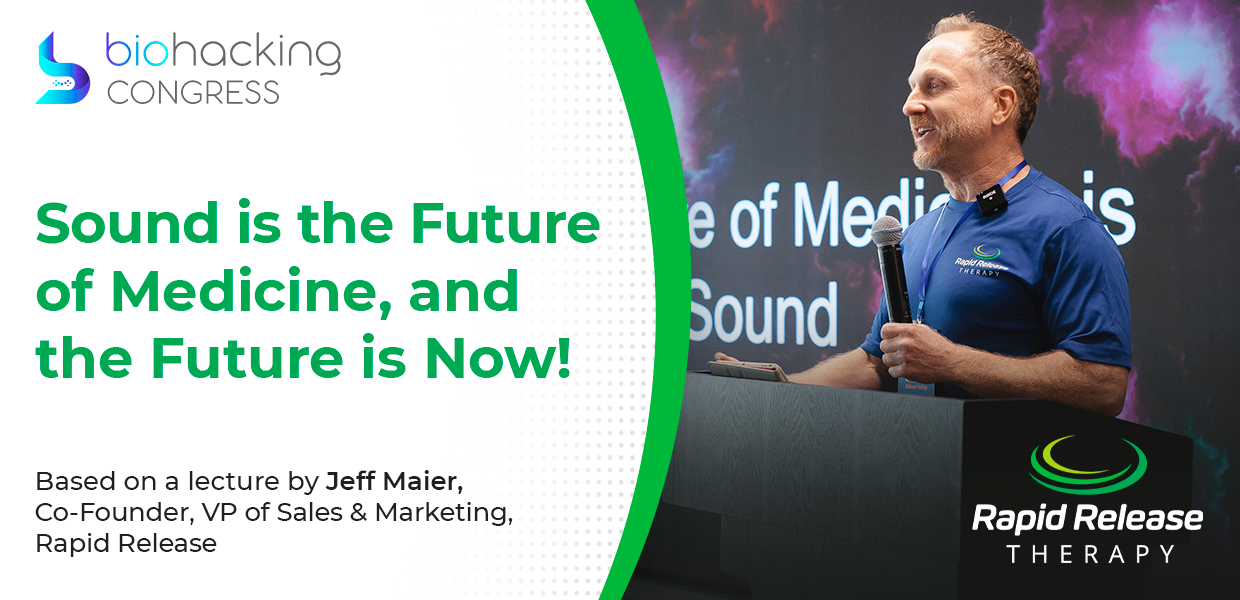Sound is the Future of Medicine, and the Future is Now!
What would you feel when hearing the sound of a siren? You’ll start to panic because this sound means something terrible is happening near you, something that may hurt you.
“Your heart rate goes up, your blood pressure goes up, adrenaline and cortisol put you into a fight. Your higher cortex gets disabled, so it's hard to have higher thoughts when you're in fight or flight mode and not only that, but you can cause brain damage if you stay in that mode for too long,” Jeff Maier Co-Founder, VP of Sales & Marketing at Rapid Release described.
What are the physics of sound and sound vibration therapy?
“Sound is a compression and rarefaction of the sound part of particles. It could be any kind of medium, underwater, and its solids. In our body, the sounds go very easily through blood, fat, and skin, but they don't go as easily through high protein content like scar tissue, ligaments, tendons, and fascia. Fascia is our highest density of sensors as pain sensors, mechano-sensor, heat, and cold.” Jeff explained.

That’s the fact that sound affects gene expression, but the question of why it affects remains unclear. Nowadays, scientists investigate this question.
There are a couple of new branches of science specifically for epigenetics. Epigenetics is the study of how your behaviors and environment can cause changes that influence the way your genes work. Jeff dived into more details about the nature of a sound - “The brain of a cell is the skin around the cell, and the nucleus is the gonads of the cell, so the cell wall is very susceptible to mechanical stimuli.
“Sauna cytology is a new field of study that uses a unique mechanism to record the vibrations and audio frequencies at the cell surface. The idea is in the future, and they can do regenerative therapy using sound waves.
“There's also a science called signal transduction which looks at the pathways that translate the environmental information into biological effects Nitrous Oxide responds to sound vibrations. Nitric Oxide is a messenger molecule that plays a role in regulating inflammation, cell growth, microcirculation, cell repair, and libido.
“The mechanical stimuli or sound vibrations have a profound effect on ion channels in the plasma membranes of the cells. Ion channels are responsible for starting specific cascades of activities inside the cell that result in different functions. Sound vibrations also affect calcium-binding ion channels. Calcium signaling is vital to the system that responds to sound vibrations.
“Another study that evaluated the effect of focused sound on the ion channels of neurons found that vibrations activated the Sodium and Potassium channels.”

Sound healing has been around for a long time. Shamans used drums to enhance the recovery through including relaxation and enhancing theta-wave production, brain-wave synchronization, and relief of emotional trauma. The didgeridoo has been around for about 40 000 years, its vibrations go deep into the body. The 99.9% sound of Tibetan bells bounces off the air skin barrier.
“My business partner, a chiropractor, Dr. Stanley Sandbridge, had different gadgets, and none worked on everything. Some would work on some people for some time, and he constantly thinks there's got to be something universal, and that will work on everybody all the time. One of his favorite machines was the vibration plates.
“All mechanical vibrations have been around for 120 years. The first one was made in 1903. But even today, almost all devices on the market have a big long frequency of about 5.8 of an inch, and they're slow.” Jeff said.
After a long time of thinking, Dr. Sandbridge came up with the idea of creating high-frequency mechanical vibration. He ended up making a prototype of it, and he tried it, the results were better than he could imagine. That’s how Rapid Release was created.

Rapid Release has a high-frequency vibration frequency of 147 hertz, which resonates with scar tissue. Scar tissue is a compilation of cells and collagen that covers the site of the injury. It can be the result of repetitive motion, injuries, surgery, burns, scraping.
Some other effects happen when you vibrate the body at this high frequency, which is called the tonic vibration reflex.
What happens when you vibrate muscles between 100 and 200 times a second? “It's pulling on the muscle spindles. As it's pushing down on the muscle belly and right next to the muscle spindles are these things called la efferent nerves. They get stimulated and therefore release alpha motor neurons that instantly relax the agonist-antagonist co-contraction mechanism. That's the same mechanism that causes spasms, cramps, and muscle guarding.” Jeff explained.
BiohackingCongress's Team is very grateful to Jeff Maier for joining our biohacking conference and giving an incredible lecture so you could learn more about biohacking your brain and biohacking your body with the help of a biohacking technology.
Watch Jeff's full lecture on Sound is the Future of Medicine and 50+ lectures, panel discussions, and performances from renowned biohackers, founders of biohacking products, and biohacking supplements with a BiohackingCongress year-long subscription. Get your access to a healthy future now! Follow this link.
Based on the lecture by Jeff Maier.
Special Access to
Exclusive TopBiohacks
and more


